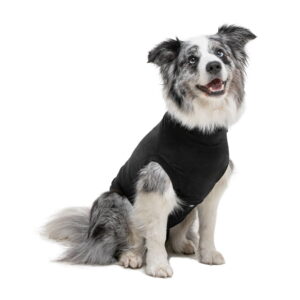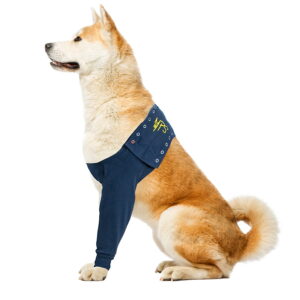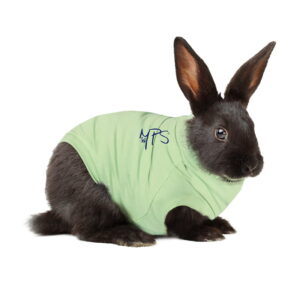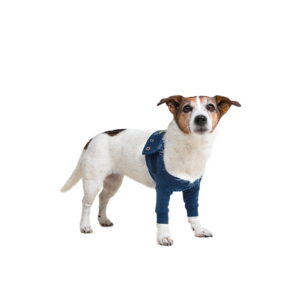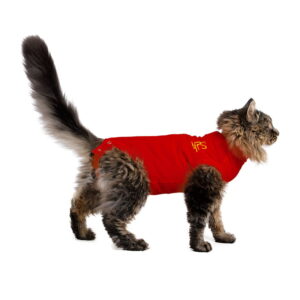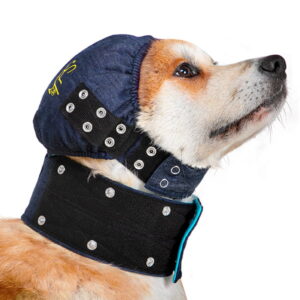Managing Incontinence in Senior Dogs and Cats with Recovery Suits
Aging comes with changes we can see—and some we can’t. If your senior dog is dribbling urine or your elderly cat is having the odd stool accident, you’re not alone. Incontinence is common, medical, and manageable. A recovery suit for dog incontinence (and cat variants) can protect skin, control odor, and keep your home cleaner—while preserving your pet’s dignity.
What Causes Incontinence in Senior Dogs and Cats?
Incontinence is a medical issue, not a behavior problem. Common causes include:
- Urethral sphincter mechanism incompetence (USMI): Often in spayed senior female dogs due to reduced estrogen.
- Neurological disease: Spinal conditions such as IVDD can interrupt nerve signals to the bladder or bowel.
- Muscle weakening with age: The “valves” simply don’t seal as well.
- Kidney disease or diabetes: Extra urine production can overwhelm control.
- Cognitive dysfunction syndrome (CDS): Confusion can disrupt learned toilet habits.
- Urinary tract infections and bladder stones: Can mimic or worsen incontinence.
Early veterinary evaluation is key. Your vet will rule out treatable causes and may prescribe medication that works alongside home hygiene tools.
Why Cleanliness and Skin Protection Matter
Left on the skin, urine and feces can cause:
- Urine scald and dermatitis (ammonia and enzymes irritate skin)
- Secondary infections and a persistent “kennel” odor in bedding and carpets
- Pain and restlessness that erode quality of life
A clean, dry barrier and a calm routine prevent problems before they start.
How Recovery Suits Help (Hygiene, Odor, Skin, Comfort)
A well-made recovery suit is a gentle, practical way to manage leaks in dogs and cats:
- Hygiene maintenance: Suits that accept absorbent pads or have pad pockets keep leaks off fur and furniture.
- Odor control: Moisture-wicking, quick-dry fabrics and washable pads reduce lingering smells.
- Skin protection: A breathable barrier helps prevent urine scald and friction sores.
- Comfort and dignity: A snug, soft garment can make pets feel secure and keep them clean between changes.
- Stable pad placement: Unlike diapers that can twist, a body suit holds pads where they’re needed.
- Easy changes: Quick-open rear panels or snap/zip access allow fast pad swaps and toileting.
Explore options: Suitical recovery suit for dog incontinence; MPS Shirt Cat.
Diapers vs Belly Bands vs Recovery Suits (Comparison)
No single solution fits every pet; many families combine tools.
Dog diapers
- Pros: High absorbency, quick to change.
- Cons: Can twist or leak; may rub; stronger odor if not changed often.
- Best for: Full urinary incontinence, travel, short stints.
Belly bands (male dogs)
- Pros: Simple for dribbles/marking; cooler than a full diaper.
- Cons: Only covers the penis; not for females; can cause scald if pads aren’t changed.
- Best for: Male dribblers, marking control.
Recovery suits
- Pros: Full-body coverage; stable pad placement; protects skin and fur; good for odor control; can pair with pads/diapers.
- Cons: Needs correct sizing and regular pad changes; initial acclimation.
- Best for: Sensitive skin, mixed leaks, night-time protection, cats who dislike diapers.
Tip: Many owners use a recovery suit at night (for skin protection and stability) and a diaper or belly band in the day for quick changes.
What to Look For in an Incontinence-Friendly Recovery Suit
- Pad compatibility: Built-in pad pockets or secure loops for washable or disposable pads.
- Quick-open rear access: For toileting and easy pad changes.
- Moisture-wicking, breathable fabric: Keeps skin dry and cool.
- Antimicrobial finish: Helps reduce odor-causing bacteria.
- Stretch and adjustability: A snug, comfortable fit that stays put.
- Machine-washable durability: Withstands frequent laundering.
- Cat-friendly patterns: For felines, look for low-stress closures and soft seams.
Recommended picks:
- Suitical Recovery Suit – DOG (water-repellent panel, breathable cotton mix)
- MPS 4-in-1 Shirt – DOG (versatile, easy-access design)
- MPS Shirt – CAT (gentle fit for felines)
How to Measure and Fit a Recovery Suit (HowTo)
You’ll need a soft tape measure and your pet standing square.
1) Measure back length: From base of neck (where a collar sits) to base of tail. 2) Measure chest girth: Around the widest part of the ribcage. 3) Measure neck girth: Where the collar sits, snug but not tight. 4) Cross-check weight: Helpful if between sizes. 5) Choose size: If between sizes, go larger for comfort. 6) Put it on: Start at the head, guide front legs through, then the torso and hind section. 7) Pad placement: Insert an absorbent pad into the pocket; ensure contact where leaks occur. 8) Movement check: Your pet should walk, lie down, and toilet naturally. Adjust as needed. 9) First 24–48 hours: Check for chafing, heat, or dampness; adjust or change pads more frequently.
Yes—dogs can eliminate while wearing many recovery suits. Use the quick-open panel for outdoor toileting or rely on pad pockets for dribbles between outings. For cats, ensure the litter box is easy to access and the suit doesn’t restrict posture.
Watch: “How to fit a recovery suit for incontinent dogs” (2:00)
Complementary Home Strategies
Night-time setup
- Use a recovery suit with a high-absorbency pad and a waterproof bed cover.
- Add an odor-control routine: quick wipe, fresh pad, morning wash in enzymatic detergent.
Travel and car tips
- Pack spare pads, wipes, a waterproof seat cover, and a travel water bowl.
- Schedule a toilet break before loading and on arrival.
Laundry and odor control
- Enzymatic cleaners for fabrics and floors (breaks down proteins, not just masking).
- Wash suits and pads in warm water; skip fabric softener; air dry or low heat.
Cat-specific setup
- Low-sided litter boxes; multiple locations; non-slip mats.
- Differentiate incontinence from spraying or stress—ask us or your vet if unsure.
Eco-friendly, budget-friendly swaps
- Washable pads and suits reduce waste and monthly costs vs disposables.
- A single suit plus a rotation of washable pads often pays for itself in weeks.
Medical Treatments at a Glance
Hygiene tools help daily life, but some pets also need medication:
- USMI (common in spayed females): Phenylpropanolamine (PPA) and/or estrogen (estriol) can improve urethral tone.
- Inflammation/UTIs: Antibiotics when indicated; always culture recurrent infections.
- Neurological causes (e.g., IVDD): Anti-inflammatories, physiotherapy, bladder expression training; assistive garments help protect skin.
- Endocrine disease (diabetes, Cushing’s): Treat the underlying condition to reduce urine volume.
- Stool consistency issues: Diet adjustments and vet-advised medications.
Always follow your vet’s guidance—products complement medical care; they don’t replace it.
When to See a Veterinarian
Book a vet visit if you notice:
- Sudden onset incontinence, blood in urine/stool, straining, or pain
- Excessive thirst/urination, weight loss, or lethargy
- Foul odor, rash, or sores on skin
- Confusion, hind-end weakness, or back pain
- Recurrent accidents despite regular changes and cleaning
FAQs
Q: Can a dog pee while wearing a recovery suit? A: Yes. Choose a suit with absorbent pad pockets or a quick-open rear panel. Dogs can eliminate cleanly while you protect skin and fur.
Q: What’s better for senior dog incontinence: diapers, belly bands, or a recovery suit? A: It depends on sex, leak type, and skin sensitivity. Diapers and belly bands absorb urine; recovery suits add full-body coverage, stable pad placement, and skin protection. Many owners combine them.
Q: How do I prevent urine scald on my dog? A: Keep skin dry with frequent pad changes, use moisture-wicking garments, clean with gentle wipes, and apply vet-approved barrier balms if recommended.
Q: Will a recovery suit help with fecal incontinence? A: It won’t stop stool, but it can contain leaks and protect skin. Pick a secure fit with easy-change panels and washable, absorbent inserts.
Q: How do I choose the right size recovery suit? A: Measure chest, neck, and back length; compare to the size chart. If between sizes, choose the larger size for comfort. See our sizing video or chat to us.
Shop Recovery Suits and Incontinence Bundles
- Suitical Recovery Suit – DOG (dog diaper alternative recovery suit)
- MPS 4-in-1 Shirt – DOG (versatile incontinence and recovery wear)
- MPS Shirt – CAT (cat diaper suit alternative)
- Washable pet incontinence pads (pad pocket compatible)
- Incontinence Care Starter Pack: recovery suit + washable pads + waterproof bed cover + enzymatic cleaner (bundle and save)
Need help? Chat to a sizing specialist. Secure payments. Fast delivery across South Africa. Easy returns.



